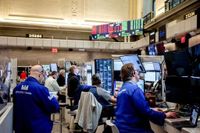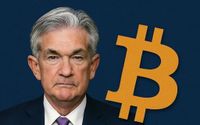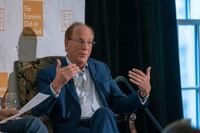The U.S. Federal Reserve is facing mounting pressure as it prepares for a crucial closed-door meeting of its Board of Governors scheduled for 11:30 AM ET today. The focus will be on reviewing advance and discount rates, a move that could inject liquidity into the markets amid a sharp global sell-off and increasing calls for aggressive rate cuts from President Donald Trump.
The financial markets are in turmoil, with major U.S. stock indices slipping into bear market territory. Asian markets, including Hong Kong, Japan, and Taiwan, experienced double-digit declines, marking their worst single-day performance in years. China's stock market also saw its most significant drop since the 2008 financial crisis. The crypto market, which had shown some resilience, succumbed to the broader market's instability, with Bitcoin falling below $75,000 and altcoins like Ethereum, Solana, and XRP down nearly 20%.
As the economic landscape shifts, President Trump has intensified his calls for the Fed to cut rates, using social media to highlight falling oil and food prices as evidence of diminishing inflation. However, Fed Chair Jerome Powell appeared cautious last week, indicating that the central bank was not in a hurry to adjust its monetary policy. Yet, the recent sell-off, dubbed "Black Monday," could force the Fed's hand.
According to the CME FedWatch Tool, interest rate traders are now anticipating four rate cuts in 2025, significantly more than the previous consensus of just one. Earlier today, the odds of a rate cut at the May FOMC meeting surged past 50%, but with that meeting still a month away, U.S. equities may require more immediate support from the Fed to stave off a recession. Today's meeting could provide the central bank with an opportunity to adjust the discount rate while keeping the Federal Funds Rate steady until the May meeting, offering essential support to the financial markets.
Typically, the market reacts negatively to interest rate cuts, but some analysts believe this time could be different. Analyst Blokchainedbb notes that Bitcoin is at a crucial support level, and an emergency rate cut could signal that the bottom is in for the cryptocurrency. If Bitcoin manages to regain its footing above its 50-week moving averages, it could become a top choice for investors.
In addition to Bitcoin, other cryptocurrencies are also showing potential. Ethereum is nearing a significant support level, and a Fed rate cut could trigger a strong rebound for the altcoin market. New investment opportunities are emerging, such as the meme coin BTC Bull (BTCBULL), which offers free Bitcoin airdrops to its holders. Meanwhile, a Solana Layer-2 coin, Solaxy (SOLX), has raised nearly $30 million in its ICO, with experts predicting it could be undervalued compared to other leading cryptocurrencies.
The bond market is also reacting to the current economic climate. On April 7, 2025, U.S. government bonds tumbled, erasing some of their largest weekly advances since August. Yields across all maturities increased by at least 20 basis points, with the 30-year bond yield rising nearly 23 basis points—its most significant one-day increase since March 2020.
Amid these developments, Larry Fink, CEO of BlackRock, raised concerns during an interview at the Economic Club of New York regarding the potential for rising inflation due to Trump's tariffs. Fink suggested there is "zero chance" the Federal Reserve will ease rates four times this year, arguing that tariffs could exacerbate inflation, necessitating higher rates instead. He noted that many CEOs he speaks with believe the economy may already be in a recession.
Trump's ongoing trade war has raised the stakes for the Federal Reserve, complicating its decisions on monetary policy. In a speech on April 4, 2025, Powell expressed concern that the tariffs could lead to higher inflation and slower growth than initially anticipated. The Fed's dual mandate includes maintaining a healthy labor market and low, stable inflation, but the latest jobs report indicated that the labor market remains strong, with 228,000 jobs added in March and an unemployment rate of 4.2%.
However, the economic outlook is clouded by fears that Trump's tariffs will stifle consumer spending and squeeze business profit margins, potentially leading to layoffs and a rise in the unemployment rate above 5%. Economists have begun to adjust their forecasts, with JPMorgan now predicting a 0.3% decline in GDP for the year, down from an earlier estimate of 1.3% growth.
As the Fed navigates these turbulent waters, Powell emphasized the importance of waiting to see how the situation unfolds before making any drastic policy changes. He acknowledged the uncertainty surrounding the economy and the potential for inflation to rise due to tariffs. The Fed's ability to manage inflation expectations while fostering employment remains a delicate balancing act.
Despite the challenges, the Fed has historically responded to economic downturns with decisive actions. However, the unique circumstances surrounding Trump's tariffs and their potential impact on inflation complicate the central bank's response strategy. As Powell noted, "It's not clear at this time what the appropriate path for monetary policy will be." The Fed's decisions in the coming weeks will be critical in shaping the economic landscape as it confronts the dual threats of inflation and slowing growth.
In light of these developments, the financial markets are bracing for the Fed's next moves, with investors keenly watching for any signs of a shift in monetary policy. The outcome of today's meeting could set the tone for the markets in the months to come, as the Fed weighs its options in a rapidly changing economic environment.








